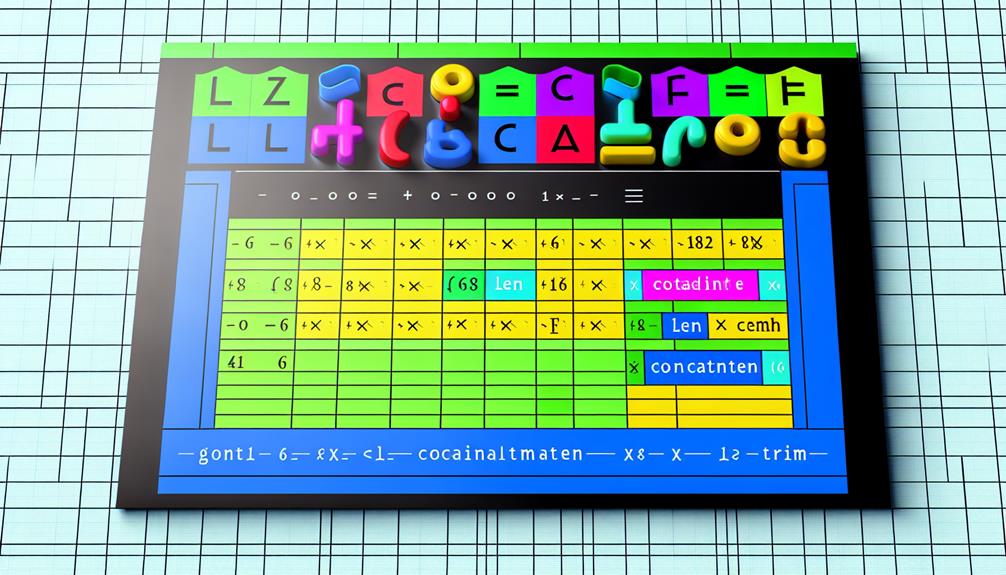Counting characters in Google Sheets cells is vital for ensuring data accuracy and compliance with character limits. The LEN function serves as the primary tool for this purpose, allowing users to determine the number of characters in individual cells efficiently. For broader applications, combining LEN with ARRAYFORMULA can assess character counts across multiple rows or columns, enhancing overall productivity. It is essential to handle special characters and spaces carefully, as they can affect counts. Understanding these aspects can improve data management practices considerably, providing valuable insights as you explore further.
Key Takeaways
- Use the LEN function to count characters in a cell, ensuring data integrity and compliance with character limits.
- Combine LEN with TRIM to remove unnecessary spaces for accurate character counting.
- Utilize ARRAYFORMULA for bulk character counting across multiple rows or columns, enhancing productivity.
- Apply conditional formatting to visualize character counts, identifying cells that exceed set limits.
- Implement data validation techniques to restrict character input, promoting accuracy in data entry.
Importance of Character Counting

Character counting in Google Sheets is an integral aspect of data management that often goes unnoticed. Understanding character limits is vital for ensuring data accuracy, particularly when dealing with user inputs, form submissions, or any text-heavy datasets. By monitoring character counts, users can prevent errors that arise from exceeding predefined limits, which can lead to data corruption or loss. Additionally, platforms like a thorough learning tool can help enhance data management skills. Moreover, it fosters a sense of accountability among team members who rely on accurate data for decision-making. In environments where collaboration is key, maintaining character integrity not only enhances individual contributions but also promotes collective efficiency. Consequently, incorporating character counting into routine data practices strengthens overall data quality and reinforces a commitment to excellence within the organization.
Using the LEN Function
The LEN function in Google Sheets serves as a fundamental tool for counting characters within a cell. By understanding its basic syntax and application, users can effectively manage text data in various contexts. This function can also be beneficial for analyzing investment data, as demonstrated in unlocking investment potential through careful data management. This discussion will explore practical examples and common use cases that illustrate the function's versatility and utility in data analysis.
LEN Function Basics
When analyzing text data in Google Sheets, understanding the LEN function is essential, as it provides a straightforward method for counting the number of characters within a cell. This function can be particularly valuable for ensuring data integrity and consistency. However, users should be aware of LEN function variations, which allow for different data types, and LEN function limitations, such as its inability to count characters in merged cells.
| Example Text | Character Count | Notes |
|---|---|---|
| "Hello, World!" | 13 | Includes punctuation |
| "Google Sheets" | 13 | Spaces count as characters |
| "12345" | 5 | Numeric values included |
Incorporating these insights will enhance your data analysis skills.
Practical Examples
One effective way to leverage the LEN function is by applying it to various scenarios that demonstrate its versatility in counting characters accurately. For instance, organizations can use LEN for text analysis to guarantee compliance with character limits in data entry forms, thereby enhancing overall data quality. By analyzing character trends, teams can identify formatting issues that may hinder content optimization. Additionally, the LEN function aids in error detection by flagging entries that exceed specified limits, facilitating data cleanup. By integrating performance metrics with user feedback, businesses can refine their communication strategies, assuring clarity and brevity. Overall, employing the LEN function in these practical examples underscores its vital role in maintaining data integrity and enhancing user experience.
Common Use Cases
While various functions in Google Sheets serve unique purposes, the LEN function stands out for its ability to accurately count characters across a range of applications. This functionality is vital for text analysis, ensuring data integrity by allowing users to assess whether inputs meet character limits. In content optimization, LEN aids in refining messaging while maintaining formatting consistency across spreadsheets. Additionally, it enhances spreadsheet performance by facilitating effective text comparison, enabling users to quickly identify discrepancies. By analyzing user feedback, organizations can leverage LEN to improve user experience and streamline data entry processes. Overall, the LEN function is an important tool for anyone seeking to maintain accuracy and efficiency in managing textual data within Google Sheets.
Combining LEN With Other Functions

Combining the LEN function with other functions in Google Sheets can greatly enhance data analysis and manipulation capabilities. By using formula combinations, users can perform advanced text analysis and optimize spreadsheet efficiency. For example, the LEN function can be combined with the TRIM function to clean up unnecessary spaces, improving data quality. Below is a simple illustration of character frequency analysis:
| Function Combination | Result |
|---|---|
| '=LEN(A1)' | Counts total characters |
| '=LEN(TRIM(A1))' | Counts characters without spaces |
| '=LEN(A1)-LEN(SUBSTITUTE(A1,"a",""))' | Counts 'a' characters |
| '=LEN(A1)-LEN(SUBSTITUTE(A1," ",""))' | Counts spaces |
These techniques enhance text manipulation and support performance optimization, making data cleaning more effective.
Counting Characters in a Range
Understanding how to count characters within a specific range in Google Sheets can considerably enhance data analysis capabilities, especially when dealing with large datasets. By utilizing functions such as LEN in combination with ARRAYFORMULA, users can effectively analyze character limits across multiple cells. This technique not only aids in text analysis but is also integral to data cleanup processes, ensuring compliance with validation rules. For instance, incorporating effective methods like creating interactive content can further streamline your analysis and enhance engagement. Effective string manipulation within ranges can streamline performance metrics and bolster formula efficiency. Additionally, counting characters contributes to data integrity, allowing for thorough error checking. Ultimately, these insights empower users with robust reporting tools, facilitating informed decision-making and enhancing collaboration within teams focused on data-driven objectives.
Handling Spaces and Special Characters

In many cases, users may encounter challenges when counting characters due to the presence of spaces and special characters within text strings in Google Sheets. Effective handling of punctuation is vital, as it can greatly alter character counts. For instance, just as in presentations where clarity and readability are paramount, users might choose to ignore whitespace, focusing solely on alphanumeric characters, which can provide a clearer analysis of text length mastering footnotes. Additionally, counting emojis requires special attention since they can represent multiple characters in a single unit, complicating the character count further. Understanding the special character impact is essential for accurate data interpretation, ensuring that users can derive meaningful insights from their spreadsheets without being misled by extraneous elements. This nuanced approach enhances the overall accuracy of character counting in Google Sheets.
Counting Characters With ARRAYFORMULA
While character counting in Google Sheets can be straightforward for individual cells, leveraging the ARRAYFORMULA function allows users to efficiently apply character counting across multiple rows or columns simultaneously. This method not only saves time but also enhances productivity, similar to how effortless file downloads can streamline tasks in PowerShell automation. By utilizing an array formula, users can circumvent the tedious process of entering formulas cell-by-cell, thereby enhancing productivity. For instance, applying the formula '=ARRAYFORMULA(LEN(A1:A))' will yield the character counts for each entry in column A, presenting a thorough overview in one step. This capability is particularly beneficial for managing character limits, especially in applications requiring compliance with specific formatting rules. Embracing ARRAYFORMULA not only streamlines workflow but also fosters a sense of community among users aiming for efficiency in data management tasks.
Visualizing Character Counts

Visualizing character counts in Google Sheets enhances data interpretation and decision-making processes. Techniques such as conditional formatting can highlight cells based on character count thresholds, while charts can provide a graphical representation for more insightful analysis. Additionally, implementing data validation techniques guarantees that character count limits are maintained, improving data integrity.
Using Conditional Formatting
Harnessing the power of conditional formatting in Google Sheets allows users to effectively visualize character counts within cells, enhancing data analysis and readability. By implementing conditional formatting rules, users can establish dynamic formatting options that adjust based on character limits. For instance, applying color scales can provide a gradient view of character counts, while data bars offer a visual cue for cell length. Error highlighting can pinpoint cells exceeding specified character thresholds, ensuring compliance with data standards. Utilizing the format painter streamlines the application of these visual cues across multiple cells. Additionally, custom formulas can tailor character count conditions, empowering users to maintain clarity in their datasets and fostering a sense of control over their information management.
Creating Charts for Analysis
Creating effective charts to analyze character counts in Google Sheets can greatly enhance the understanding of data distributions and trends. Utilizing various chart types, such as bar graphs or pie charts, allows for a clear graphical representation of character counts. By incorporating visual elements like color schemes, one can highlight significant data trends, facilitating audience engagement. Presentation tools within Google Sheets enable seamless chart customization, ensuring that the visual output aligns with the intended message. Effective charts not only display data but also tell a story, guiding viewers through the insights derived from character counts. Ultimately, well-designed charts serve as powerful tools for analysis, fostering a deeper connection with the data for all stakeholders involved.
Data Validation Techniques
Effective data visualization lays the groundwork for implementing robust data validation techniques in Google Sheets, particularly when analyzing character counts. By establishing clear character limits through validation rules, users can enhance data entry accuracy. Input restrictions can be configured to prevent users from exceeding specified character counts, thereby promoting consistency checks across datasets. Additionally, integrating automated checks can streamline this process, ensuring that any discrepancies are caught early. Error messages can provide immediate user feedback, guiding them to correct their input without frustration. This proactive approach fosters a collaborative environment where data integrity is prioritized, ultimately leading to a smoother experience for all users involved in data management tasks.
Tips for Efficient Data Management
In the domain of data management, implementing systematic approaches is vital for maintaining efficiency and accuracy. Effective data organization forms the backbone of spreadsheet optimization, allowing users to utilize efficiency strategies that enhance productivity. By prioritizing character tracking within cells, one can guarantee accurate data entry, which greatly contributes to error reduction. Incorporating formatting tips can further streamline workflows, making sure that information is easily readable and accessible. Regular data auditing is essential, as it identifies inconsistencies and promotes a culture of accountability among team members. Ultimately, these practices not only foster workflow improvement but also cultivate a sense of belonging within teams, as each member contributes to a shared goal of operational excellence.
Frequently Asked Questions
Can I Count Characters in Multiple Sheets at Once?
Counting characters across multiple sheets can be accomplished using effective character counting techniques. By employing multi-sheet formulas, users can streamline the process of aggregating data efficiently. For example, utilizing functions like 'SUMPRODUCT' combined with 'LEN' can facilitate the calculation of character counts from various sheets simultaneously. This approach not only saves time but also enhances data analysis capabilities, fostering a sense of belonging among users seeking to improve their spreadsheet management skills.
What Is the Maximum Character Limit in Google Sheets?
Google Sheets imposes a maximum character limit of 50,000 characters per cell. This constraint is essential for users to take into account when utilizing text functions, as exceeding this limit may result in data loss or errors. Understanding these character limits enables users to effectively manage their data and utilize the platform to its fullest potential. By adhering to these guidelines, individuals can guarantee seamless data processing and maintain the integrity of their spreadsheets.
How Do I Count Characters Without Counting Spaces?
To count characters without including spaces, one can employ various counting methods utilizing character functions. Specifically, the formula =LEN(TRIM(A1))-LEN(SUBSTITUTE(A1," ","")) effectively calculates the number of spaces and deducts this from the total character count. This analytical approach guarantees precision, allowing users to accurately assess textual content. By leveraging such functions, individuals can enhance their data management capabilities and foster a stronger understanding of character utilization in their documents.
Are There Any Keyboard Shortcuts for Character Counting?
While there are no specific keyboard shortcuts dedicated solely to character counting across most applications, users can leverage existing shortcuts to streamline their workflow. For instance, utilizing "Ctrl + C" to copy text followed by "Ctrl + V" in a character counting tool can expedite the process. Additionally, some text editors may offer built-in character counting features, accessible through shortcuts, facilitating efficient character analysis without extensive manual effort.
Can I Set up Notifications for Character Limits in Cells?
Setting up notifications for character limits in cells can enhance data management efficiency. Employing notification triggers allows users to receive immediate alerts when specified character thresholds are approached or exceeded. Implementing character alerts can help maintain data integrity across collaborative projects, ensuring that all team members adhere to established guidelines. By utilizing these features, teams can foster a cohesive environment that values precision and accountability in information handling.



